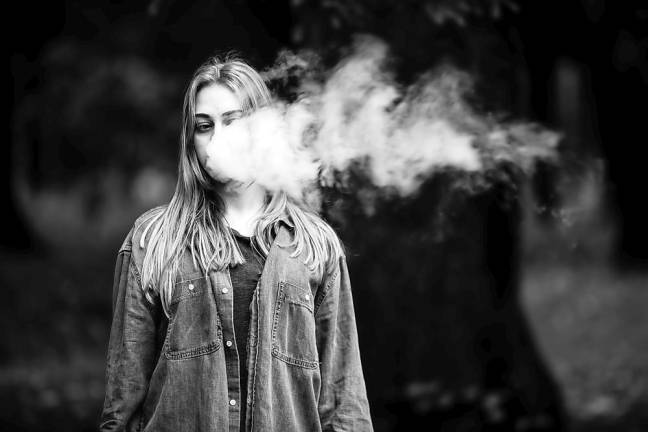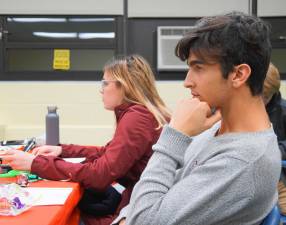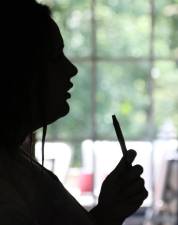15 teen overdoses in two weeks stoke fears about new generation of synthetic marijuana
Overdoses. A spate of overdoses in mid-Hudson high schools point to the danger of mysterious and easily-available synthetic chemical compounds marketed to youngsters as cures for depression and anxiety. Freshmen and sophomores still struggling to find their place in school after two years of Covid disruptions are particularly susceptible, school officials say.

At least 15 teenagers in the mid-Hudson region overdosed in the first half of March on marijuana-type products, ending up in a hospital or urgent care.
A dozen of those bad reactions happened in Orange County — at least four at high schools — mostly in Pine Bush, Monroe, Warwick and Newburgh, said Orange County District Attorney David Hoovler. All have recovered, he said.
“Some of them used regular marijuana, some of them were using vaping devices with unknown substances, and some of them used synthetic,” said Hoovler. “What it was, most of them will never know.”
The Crawford Police Chief, Dominic Blasko, responded to one of three overdoses at Pine Bush High School. “What we saw in a couple situations, eyes rolling back in the head, shakes and all that stuff, and they were not communicative,” he said. “Some people say it’s a zombie-like state, but when their eyes are rolling back in their heads, when they’re shaking, that’s a medical concern.”
The overdoses varied widely in severity. Many were in the ballpark of the student who smoked up before school and ended up in the nurse’s office profusely sweating, with high blood pressure, nausea, headache, and an elevated heart rate, which automatically prompts a 9-1-1 call. One Pine Bush student collapsed while walking between classes, conscious but unable to speak or move. The school cleared the hallways while awaiting the first responders.
Why now?
Hoovler called the increase in overdoses “alarming” in a joint public safety warning with the Police Chiefs Association of Orange County. Come springtime, he said, there’s always an uptick in alcohol and substance abuse, as the weather warms and graduation approaches. But this number of bad reactions was exceptional. “Teenagers by nature make bad decisions. We were all there,” he said. “They think they’re gonna, I guess, smoke some weed before school, and next thing you know they’re going to the hospital. Or they think they’re going to go vape with their friends on a Friday night, and Saturday morning they’re the sickest they’ve ever been in their life.”
He urged parents to talk to kids about dangerous substances that may seem benign but could be super-potent, or laced with life-threatening illicit drugs, like fentanyl. “You never know what is in the substance you’re getting,” he said.
Dr. Tucker Woods is the chief medical officer of Restorative Management Corp., a substance abuse rehab facility with offices in Sullivan and Orange counties. He wonders if fentanyl-laced marijuana was a factor in the recent spate of overdoses. “What we’re mostly seeing is marijuana laced with opioids,” he said. “We’re seeing that constantly — constantly. Every week. Because the patients will swear, I’m not using opioids, I’m not using opioids, and then as soon as they stop smoking the pot, their drug screen goes opioid-negative,” said Woods. The phenomenon turns up in patients who smoke and who vape marijuana, he said, though primarily the former.
Complicating matters are serious drug interactions, as happened in Pine Bush, said Interim Superintendent Donna Geidel. “Often our young people are on medications, and they’re not thinking about the potential interactions, even with something as simple as alcohol,” she said.
According to Geidel, one of the Pine Bush students who overdosed after vaping a marijuana substance had also taken Suboxone — a narcotic used to treat opioid addiction — and was on prescription medications.
“Everyone wants to say that these are bad kids,” said Pine Bush High School Principal Aaron Hopmayer, speaking at a March 16 forum on substance abuse. “That’s an absolute bald-faced lie, all right? I’m telling you right now, these are good kids. These are good kids, and they made a mistake. So let’s be clear that the population we’re dealing with right now is not your bottom-of-the-barrel students.”
Can we stop calling it marijuana?
While multiple substances were involved in the Pine Bush overdoses, all three involved vaping liquid marijuana, according to Blasko. Whether the vapes contained naturally occurring or synthetic marijuana was the subject of heated debate between the superintendent and a parent at the drug abuse forum. Geidel said the vapes had been sent out for toxicology testing.
“Can we stop calling it marijuana?” said a mom of four who introduced herself as Jillian. “Start calling it what it is. People will be less confused. Call it Spice, call it K2, call it synthetic, call it ‘mixed-with-chemicals,’ whatever you need to call it. It is not marijuana. It’s not straight THC. That is why parents are angry. This is not straight marijuana.” She added, “Tell the ugly truth because our students need to hear the ugly truth.”
Meanwhile, in Sullivan County, three teenage boys face felony charges for allegedly selling cannabis cookies at school, landing three girls in the hospital. Police responded to a 9-1-1 call to find one girl in the nurse’s office on March 15 in an “altered mental state” and having difficulty breathing, according to a press release from the Monticello Police Department. Three girls, all exhibiting similar symptoms, were taken to the hospital for evaluation. School surveillance video caught the drug sale, according to Monticello Police Lieutenant Mark Johnstone.
“I think what happens is with the synthetic marijuana, the K2 and those products, it’s a little bit more than the young person thinks, and they take too much, and that’s why we have these reactions,” said Blasko.
Exacerbating the problem, Blasko believes, is the sloppy roll-out of recreational marijuana, which has thrown the door open to a wild west black market. “The stores haven’t opened, but it’s legal. And so now we’re dealing with a lot of stuff where people are taking stuff that isn’t really regulated well.”
‘All sorts of fun fashions’
Though marijuana is legal only for adults, kids today have about as much trouble getting it as the previous generation had in getting their hands on alcohol, said Blasko — which is to say, not much.
Marijuana has been around forever, said MaryAlice Kovatch of Alcoholism and Drug Abuse Council of Orange County, but has become much more dangerous to people who aren’t well-informed. The industry is putting pure THC into liquids and edibles “with little to no CBD to counteract those effects. That’s when we’re seeing kids have really scary side effects,” like racing heart and high blood pressure, or, on the other end of the spectrum, an inability to move.
Kovatch, speaking at the forum, held up a pink candy potentially containing up to six servings of THC. “When they go to the gas station and they see something that says it contains CBD, they want to try it, because the industry has told them that CBD will treat their anxiety, or CBD will treat their depression, or THC.”
As of Feb. 28, poison control centers nationwide had fielded over 1,000 calls about naturally occurring CBD exposures so far this year, and just 88 calls involving the lab-made versions. But although they are less prevalent, the imitations are far more dangerous.
New Jersey and New York banned synthetic marijuana in 2012, and Pennsylvania eventually followed suit in 2011. But producers get around the rules by making slightly different products, slickly designed to appeal to youth, said Tina Aue, director of prevention services at the Center for Prevention & Counseling in Newton, N.J.
Aue said the first generation of synthetic marijuana started popping up about a decade ago in the form of a potpourri-like mixture of plant material sprayed with psychoactive chemicals and sold in pocket-sized foil packets with names like K2 and Spice. The havoc it wrought included suicides, violent seizures, and one case of fatal lung damage in a 14-year-old Pennsylvania boy who smoked it out of a Pez dispenser, according to the New Jersey Attorney General’s office.
“This is very similar to that situation, except now we have the vapes, and this product also comes in vape form,” said Aue. “Because of the popularity of vapes, I’m thinking we’re seeing it a little more this time, because kids aren’t perceiving it as harmful.”
Then there’s Delta-8, a synthetic marijuana whose psychoactive component is derived from CBD extracted from legal hemp, which makes it legal for use by those over 18. But Principal Hopmayer, at the forum, said it’s being sold to his underage students. “I’m telling you right now, Delta-8 THC is being marketed in our community, is legal, and is getting kids high, period,” he said. “It is being sold in our gas stations. It comes in gummy worms, it comes in all sorts of fun fashions that is being marketed for kids.”
Goshen Village Police Chief James Watt said he’s seen synthetic marijuana occasionally but never an overdose from it. “It did come out about a decade ago, and it was causing problems then, as I recall, but we haven’t seen that recently,” he said.
In neighboring Sussex County, N.J., “we haven’t heard specifically of overdoses happening,” said Aue. “But that being said, it might just be a matter of time.”
Teen vaping is the norm
Geidel called vaping “one of our greatest challenges,” practiced by an estimated 70 percent of Pine Bush high schoolers. Of those who carry a vape pen, Principal Hopmayer said, the vast majority possess both marijuana and nicotine cartridges.
“It’s very difficult to detect,” said Geidel. “Kids have a lot of pockets in their clothes. The way that they use the devices is very under the radar, it’s not like smoking a cigarette. There’s no smoke coming out, no vapor.”
Kovatch said some kids “cannot get through a school day without being altered in some way.”
The parents of the three students who overdosed, said Geidel, were unaware that their kids had been using any illegal drugs when they got the dreaded call. The students are facing disciplinary action for possession, she said.
“It’s going on in our middle schools. We cannot pretend that it’s not,” said Geidel. Just that day, she said, she had her first incident of a student vaping in elementary school.
Hopmayer said the school has seen more disciplinary problems than usual this year, particularly among freshmen and sophomores still struggling to find their place in the high school after two years at home. He’s seen fighting, suspensions, cutting classes, vaping in the bathrooms, and one kid going so far as to charge his vape in the weight room. Part of the problem is a significant shortage of staff, including security guards and school monitors. “When you have a lack of security, kids know it,” said Hopmayer. The school is taking steps to fill that need, with the help of Covid funds.
Schools as de-facto hospitals
Hoovler acknowledged the good relationships that school nurses have with students. “Most of the time they find out what is causing the illness by just asking the student, what did you take?” he said.
But when, for instance, an overdosing student can’t talk, the cause of their distress is mystifying.
Nurses are trained to make a drug recognition evaluation, said Geidel. With an observer present, they take vitals, perform an eye exam and other tests similar to a DUI exam, and take a statement, she said. One telltale sign, she said, is the eyes.
“With the Covid nightmare that we’ve all been in, the symptoms are wide and varied, and every kid responds differently, so we always have to suspect that it might be a medical condition,” said Geidel. “In fact, with this one student that I happened to see, we were baffled about what it could be. We had literally 200 years of experience in (the principal’s) office, talking about it, what it could potentially be, and we had a discussion of everything from edibles to marijuana to Covid.”
Then they start looking at the medical history of the student. In the case of drug impairment or overdose, 9-1-1 is called for transport to the hospital.
All the Pine Bush school buildings stock the antidote Narcan, aid Geidel, and the nurses are trained to use it. One time, she said, a parent suffered an overdose at an elementary school, and the nurse administered Narcan. “A lot of people use our schools after school,” she said, for sporting events or concerts.
Another time, Crispell Middle school Principal John Boyle was leaving school when he spotted a man overdosing on the sidewalk with his young child nearby. Geidel said that Boyle administered Narcan. “So it’s not only for our schools,” she said. “It’s for our community as a whole.”
“I think what happens is with the synthetic marijuana, the K2 and those products, it’s a little bit more than the young person thinks, and they take too much, and that’s why we have these reactions.” Crawford Police Chief Dominic Blasko




